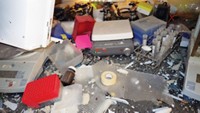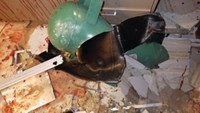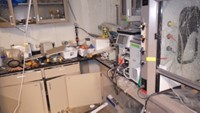Advertisement
Grab your lab coat. Let's get started
Welcome!
Welcome!
Create an account below to get 6 C&EN articles per month, receive newsletters and more - all free.
It seems this is your first time logging in online. Please enter the following information to continue.
As an ACS member you automatically get access to this site. All we need is few more details to create your reading experience.
Not you? Sign in with a different account.
Not you? Sign in with a different account.
ERROR 1
ERROR 1
ERROR 2
ERROR 2
ERROR 2
ERROR 2
ERROR 2
Password and Confirm password must match.
If you have an ACS member number, please enter it here so we can link this account to your membership. (optional)
ERROR 2
ACS values your privacy. By submitting your information, you are gaining access to C&EN and subscribing to our weekly newsletter. We use the information you provide to make your reading experience better, and we will never sell your data to third party members.
Lab Safety
Explosion at the University of Hawaii seriously injures researcher
Thea Ekins-Coward lost an arm, local media report
by Jyllian Kemsley
March 21, 2016
A 29-year-old researcher was seriously injured in a lab explosion at the University of Hawaii, Mānoa, on March 16.
The researcher is Thea Ekins-Coward, and she lost an arm and suffered other injuries, according to local media reports. When C&EN inquired about her condition on March 20, Queen’s Medical Center, the facility where she is hospitalized, declined to release any information.
Ekins-Coward is listed as a postdoctoral researcher in the alternative fuels group at the Hawaii Natural Energy Institute (HNEI), which is a research unit within the university. The university has not confirmed that Ekins-Coward was the person injured.
The lab in which the explosion happened was operated by HNEI and focuses on renewable energy and degradable bioplastics, said Brian Taylor, dean of the School of Ocean & Earth Science & Technology, during a March 17 news conference. At the time of the incident, the researcher who was injured was combining hydrogen, carbon dioxide, and oxygen gases from high-pressure cylinders into a lower pressure container. The mixture was to be used as a feedstock to grow cells. “Since 2008, when the project began, the process has been used almost daily and without incident,” Taylor said.

The injured researcher had received general and lab-specific safety training, Environmental Health & Safety Office director Roy Takekawa said at the news conference. The lab was last inspected in January and passed all requirements, Takekawa said.
Although the injured researcher was alone in the lab at the time of the incident, others were nearby. Two public safety officers and a graduate student evacuated her from the facility, chancellor Robert Bley-Vroman said at the news conference. “We are extremely grateful to those first three responders who acted so quickly to get the injured individual to the hospital,” Bley-Vroman said. “Our thoughts and prayers are with the individual who was injured.”
News media photos taken outside the lab show cracked windows, walls, and ceiling tiles, and a bent door. A sign on the door lists the emergency contact as Jian Yu, an HNEI staff researcher who works on microbial bioprocessing, bioreactor engineering, biofuels, and biomaterials. The sign also says that the lab contains bacteria and requires biosafety level 2 practices, which apply to work involving agents that pose moderate hazards to personnel and the environment.
HNEI has initiated a comprehensive safety review of all its laboratory operations, Taylor said. The building was found to be structurally sound and reopened on March 18, although the damaged lab remains closed.





Join the conversation
Contact the reporter
Submit a Letter to the Editor for publication
Engage with us on Twitter